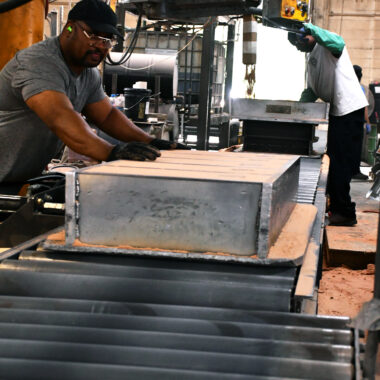Study the Globe of Aluminum Casting: Recognizing the Different Methods
Aluminum spreading is a fundamental procedure in the production industry, with numerous methods utilized to develop accurate and detailed components. From the standard sand spreading method to the sophisticated die spreading process, each technique supplies unique benefits depending on the needs of the project.
Sand Casting Approach
Sand spreading, a widely-used approach in light weight aluminum spreading procedures, includes producing mold and mildews made of compacted sand for pouring molten metal. When the mold and mildew is prepared, it is safely placed in a flask and molten aluminum is poured into the cavity.
After the metal has actually cooled down and strengthened, the sand mold is escaped to disclose the aluminum casting. Sand spreading permits the manufacturing of complicated shapes and huge components that may be challenging or expensive to generate utilizing various other approaches. It is additionally a sustainable technique as the sand can be recycled and made use of multiple times, decreasing waste in the casting procedure.
Long-term Mold Strategy

One significant benefit of the Long-term Mold And Mildew Method is the enhanced dimensional precision it provides. The steel mold permits tighter tolerances and finer details in the last light weight aluminum spreadings contrasted to sand spreading techniques. This precision makes it a preferred selection for applications where limited dimensional control is critical, such as in the automotive and aerospace sectors.

Pass Away Casting Refine

Financial Investment Casting Technique
Making use of an accuracy casting approach, Investment Casting Strategy entails creating intricate light weight aluminum parts by pouring liquified metal into a ceramic mold and mildew. This procedure, additionally referred to as lost-wax casting, begins with the production of a wax pattern of the desired part. This wax pattern is after that covered with a ceramic material to create a shell. As soon as the ceramic covering is solidified, it is heated to get rid of the wax, leaving a hollow ceramic mold and mildew.
Financial investment casting is commonly made use of for manufacturing parts in industries where complex designs and tight resistances are called for, such as aerospace, auto, and clinical equipment. The convenience and accuracy of the Investment Casting Strategy make it an important method in the world of light weight aluminum spreading.
Lost Foam Casting Method
Having discovered the detailed precision of Investment Casting Approach, the emphasis currently moves to the cutting-edge technique of Lost Foam Casting in light weight aluminum part production. Lost Foam Spreading, also called evaporative pattern casting, is a modern method where a foam pattern of the desired component is produced and after that coated with a refractory product. The coated foam pattern is then hidden in sand, and molten aluminum is put into the mold and mildew. As the steel fills up the mold, the foam vaporizes as a result of the warmth, leaving a tidy cavity in the shape of the desired component.
Among the main benefits of Lost Foam Casting is its capacity to generate intricate shapes with intricate information, typically in a solitary item without the requirement for added machining. This technique is likewise understood for its high dimensional precision and smooth surface coating. In Addition, Lost Foam Casting is a cost-effective procedure as it minimizes the requirement for cores and permits for the manufacturing of light-weight elements. have a peek at these guys In spite of its benefits, Lost Foam Casting needs careful control of the spreading process to guarantee and stop problems high quality components.
Verdict
In conclusion, light weight aluminum spreading provides a selection of methods such as sand casting, long-term mold and mildew technique, die spreading, investment casting, and shed foam spreading. Each technique has its own advantages and applications, making light weight aluminum casting a versatile over here and widely utilized procedure in numerous sectors. Understanding the differences between these approaches is important in picking one of the most ideal spreading technique for particular manufacturing needs.
Sand casting, a widely-used technique in light weight aluminum spreading procedures, involves creating molds made of compressed sand for pouring molten metal. aluminum casting.The Long-term Mold And Mildew Strategy, like sand spreading, is one more widespread approach used in light weight aluminum spreading procedures, supplying unique advantages in terms of mold reusability and dimensional precision. The steel mold enables for tighter tolerances and better information in the last light weight aluminum spreadings contrasted to sand spreading techniques. The 2 major kinds of die spreading are cool chamber pass away spreading and warm chamber pass away spreading, each appropriate for various types of aluminum alloys.In conclusion, light weight aluminum spreading Homepage supplies a range of approaches such as sand spreading, long-term mold and mildew strategy, pass away casting, investment casting, and shed foam spreading
Comments on “The Ultimate Guide to Aluminum Casting: Expert Insights and Ideal Practices”